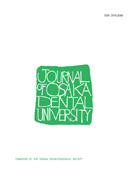Volume 42, Issue 2
Displaying 1-7 of 7 articles from this issue
- |<
- <
- 1
- >
- >|
-
Article type: Article
2008 Volume 42 Issue 2 Pages 95-100
Published: 2008
Released on J-STAGE: December 22, 2016
Download PDF (520K) -
Article type: Article
2008 Volume 42 Issue 2 Pages 101-105
Published: 2008
Released on J-STAGE: December 22, 2016
Download PDF (600K) -
Article type: Article
2008 Volume 42 Issue 2 Pages 107-112
Published: 2008
Released on J-STAGE: December 22, 2016
Download PDF (1004K) -
Article type: Article
2008 Volume 42 Issue 2 Pages 113-120
Published: 2008
Released on J-STAGE: December 22, 2016
Download PDF (944K) -
Article type: Article
2008 Volume 42 Issue 2 Pages 121-130
Published: 2008
Released on J-STAGE: December 22, 2016
Download PDF (968K) -
Article type: Article
2008 Volume 42 Issue 2 Pages 131-135
Published: 2008
Released on J-STAGE: December 22, 2016
Download PDF (432K) -
Article type: Article
2008 Volume 42 Issue 2 Pages 137-142
Published: 2008
Released on J-STAGE: December 22, 2016
Download PDF (644K)
- |<
- <
- 1
- >
- >|
